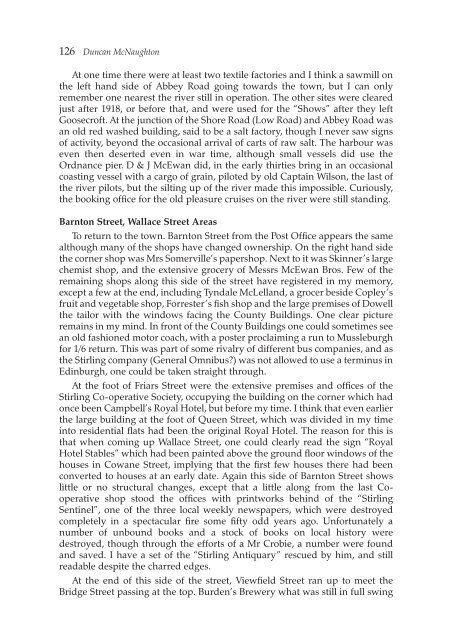the Forth Naturalist Historian - Forth Naturalist and Historian ...
the Forth Naturalist Historian - Forth Naturalist and Historian ...
the Forth Naturalist Historian - Forth Naturalist and Historian ...
You also want an ePaper? Increase the reach of your titles
YUMPU automatically turns print PDFs into web optimized ePapers that Google loves.
126 Duncan McNaughton<br />
At one time <strong>the</strong>re were at least two textile factories <strong>and</strong> I think a sawmill on<br />
<strong>the</strong> left h<strong>and</strong> side of Abbey Road going towards <strong>the</strong> town, but I can only<br />
remember one nearest <strong>the</strong> river still in operation. The o<strong>the</strong>r sites were cleared<br />
just after 1918, or before that, <strong>and</strong> were used for <strong>the</strong> “Shows” after <strong>the</strong>y left<br />
Goosecroft. At <strong>the</strong> junction of <strong>the</strong> Shore Road (Low Road) <strong>and</strong> Abbey Road was<br />
an old red washed building, said to be a salt factory, though I never saw signs<br />
of activity, beyond <strong>the</strong> occasional arrival of carts of raw salt. The harbour was<br />
even <strong>the</strong>n deserted even in war time, although small vessels did use <strong>the</strong><br />
Ordnance pier. D & J McEwan did, in <strong>the</strong> early thirties bring in an occasional<br />
coasting vessel with a cargo of grain, piloted by old Captain Wilson, <strong>the</strong> last of<br />
<strong>the</strong> river pilots, but <strong>the</strong> silting up of <strong>the</strong> river made this impossible. Curiously,<br />
<strong>the</strong> booking office for <strong>the</strong> old pleasure cruises on <strong>the</strong> river were still st<strong>and</strong>ing.<br />
Barnton Street, Wallace Street Areas<br />
To return to <strong>the</strong> town. Barnton Street from <strong>the</strong> Post Office appears <strong>the</strong> same<br />
although many of <strong>the</strong> shops have changed ownership. On <strong>the</strong> right h<strong>and</strong> side<br />
<strong>the</strong> corner shop was Mrs Somerville’s papershop. Next to it was Skinner’s large<br />
chemist shop, <strong>and</strong> <strong>the</strong> extensive grocery of Messrs McEwan Bros. Few of <strong>the</strong><br />
remaining shops along this side of <strong>the</strong> street have registered in my memory,<br />
except a few at <strong>the</strong> end, including Tyndale McLell<strong>and</strong>, a grocer beside Copley’s<br />
fruit <strong>and</strong> vegetable shop, Forrester’s fish shop <strong>and</strong> <strong>the</strong> large premises of Dowell<br />
<strong>the</strong> tailor with <strong>the</strong> windows facing <strong>the</strong> County Buildings. One clear picture<br />
remains in my mind. In front of <strong>the</strong> County Buildings one could sometimes see<br />
an old fashioned motor coach, with a poster proclaiming a run to Mussleburgh<br />
for 1/6 return. This was part of some rivalry of different bus companies, <strong>and</strong> as<br />
<strong>the</strong> Stirling company (General Omnibus?) was not allowed to use a terminus in<br />
Edinburgh, one could be taken straight through.<br />
At <strong>the</strong> foot of Friars Street were <strong>the</strong> extensive premises <strong>and</strong> offices of <strong>the</strong><br />
Stirling Co-operative Society, occupying <strong>the</strong> building on <strong>the</strong> corner which had<br />
once been Campbell’s Royal Hotel, but before my time. I think that even earlier<br />
<strong>the</strong> large building at <strong>the</strong> foot of Queen Street, which was divided in my time<br />
into residential flats had been <strong>the</strong> original Royal Hotel. The reason for this is<br />
that when coming up Wallace Street, one could clearly read <strong>the</strong> sign “Royal<br />
Hotel Stables” which had been painted above <strong>the</strong> ground floor windows of <strong>the</strong><br />
houses in Cowane Street, implying that <strong>the</strong> first few houses <strong>the</strong>re had been<br />
converted to houses at an early date. Again this side of Barnton Street shows<br />
little or no structural changes, except that a little along from <strong>the</strong> last Cooperative<br />
shop stood <strong>the</strong> offices with printworks behind of <strong>the</strong> “Stirling<br />
Sentinel”, one of <strong>the</strong> three local weekly newspapers, which were destroyed<br />
completely in a spectacular fire some fifty odd years ago. Unfortunately a<br />
number of unbound books <strong>and</strong> a stock of books on local history were<br />
destroyed, though through <strong>the</strong> efforts of a Mr Crobie, a number were found<br />
<strong>and</strong> saved. I have a set of <strong>the</strong> “Stirling Antiquary” rescued by him, <strong>and</strong> still<br />
readable despite <strong>the</strong> charred edges.<br />
At <strong>the</strong> end of this side of <strong>the</strong> street, Viewfield Street ran up to meet <strong>the</strong><br />
Bridge Street passing at <strong>the</strong> top. Burden’s Brewery what was still in full swing



